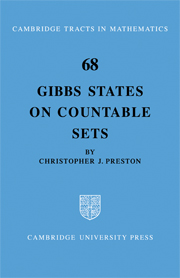Book contents
- Frontmatter
- Contents
- Preface
- 1 Gibbs states and Markov random fields
- 2 Interacting particle systems
- 3 Coupled Markov chains
- 4 Gibbs states and Markov random fields on countable graphs
- 5 Gibbs states on countable sets
- 6 Kirkwood–Salsburg equations
- 7 Involutions of P(S)
- 8 Attractive and supermodular potentials
- 9 Attractive pair potentials
- 10 Examples of phase transition
- 11 11 The extreme points of GV
- Appendix The Lee-Yang circle theorem revisited
- Bibliography
- Index
1 - Gibbs states and Markov random fields
Published online by Cambridge University Press: 07 October 2011
- Frontmatter
- Contents
- Preface
- 1 Gibbs states and Markov random fields
- 2 Interacting particle systems
- 3 Coupled Markov chains
- 4 Gibbs states and Markov random fields on countable graphs
- 5 Gibbs states on countable sets
- 6 Kirkwood–Salsburg equations
- 7 Involutions of P(S)
- 8 Attractive and supermodular potentials
- 9 Attractive pair potentials
- 10 Examples of phase transition
- 11 11 The extreme points of GV
- Appendix The Lee-Yang circle theorem revisited
- Bibliography
- Index
Summary
Let ∧ be a finite set and let P(∧) denote the set of subsets of ∧. In this chapter we will look at various classes of probability measures on P(∧) that might arise in simple physical and biological models. The points of ∧ can be interpreted as sites, each of which can be either empty or occupied by a particle (or some other entity); the subset A ∈ P(∧) will be regarded as describing the state of the model when the points of A are occupied and the points of ∧ - A are empty. The elements of P(∧) will sometimes be called configurations. Most physical models (even simple ones) involving configurations would be dynamic in nature; the probability measures that we will look at will describe the distribution of the configurations when the model is in some state of dynamic equilibrium.
The set ∧, representing the sites in the model, can be expected to have some additional structure, for example we might know the distances between the sites, or we might know that certain sites are connected. We will consider structures on ∧ of the latter kind, thus we suppose that the points of ∧ are the vertices of some finite graph G = (∧, e), where e is the set of edges of G. We do not allow G to have any multiple edges or loops. The following notation and definitions will be used: If x,y ∈ ∧ and there is an edge of the graph between x and y then we will say that x and y are neighbours.
- Type
- Chapter
- Information
- Gibbs States on Countable Sets , pp. 1 - 9Publisher: Cambridge University PressPrint publication year: 1974



